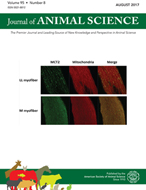-
Views
-
Cite
Cite
J. K. Apple, M. E. Dikeman, L. V. Cundiff, J. W. Wise, Determining beef carcass retail product and fat yields within 1 hour postmortem, Journal of Animal Science, Volume 69, Issue 12, December 1991, Pages 4845–4857, https://doi.org/10.2527/1991.69124845x
Close - Share Icon Share
Abstract
Hot carcasses from 220 steers (progeny of Hereford or Angus dams mated to Angus, Charolais, Galloway, Gelbvieh, Hereford, Longhorn, Nellore, Piedmontese, Pinzgauer, Salers, or Shorthorn sires) were used to develop equations to estimate weights and percentages of retail product (RP) and trimmable fat (TF) yields. Independent variables examined were 1) 12-13th rib fat probe (12RFD), 2) 10-11th rib fat probe (10RFD), 3) external fat score (EFS), 4) percentage of internal fat estimated hot (H%KPH), 5) hindquarter muscling score (HQMS), and 6) hot carcass weight (HCW). Right sides of the carcasses were fabricated into boneless retail cuts, trimmed to .76 cm of subcutaneous and visible intermuscular fat, and weighed. Cuts were trimmed to 0 cm of subcutaneous and visible intermuscular fat and reweighed. Multiple linear regression equations containing 12RFD, EFS, H%KPH, and HCW accounted for 95 and 89% of the variation in weight of total RP at .76 and 0 cm of fat trim, respectively. When weights of RP from the four primal cuts (.76 and 0 cm of fat trim) were the dependent variables, equations consisting of 12RFD, EFS, H%KPH, and HCW accounted for 93 to 84% of the variation. Hot carcass equations accounted for 83% of the variation in weight of total TF at both .76 and 0 cm of fat trim. Furthermore, equations from hot carcass data accounted for 54 and 51% of the variation in percentage of total RP and 57 and 50% of the variation in percentage of RP from the four primal cuts at .76 and 0 cm of fat trim, respectively. Hot carcass prediction equations accounted for 72% of the variation in percentage of total TF at both fat trim levels. Hot carcass equations were equivalent or superior to equations formulated from chilled carcass traits.





